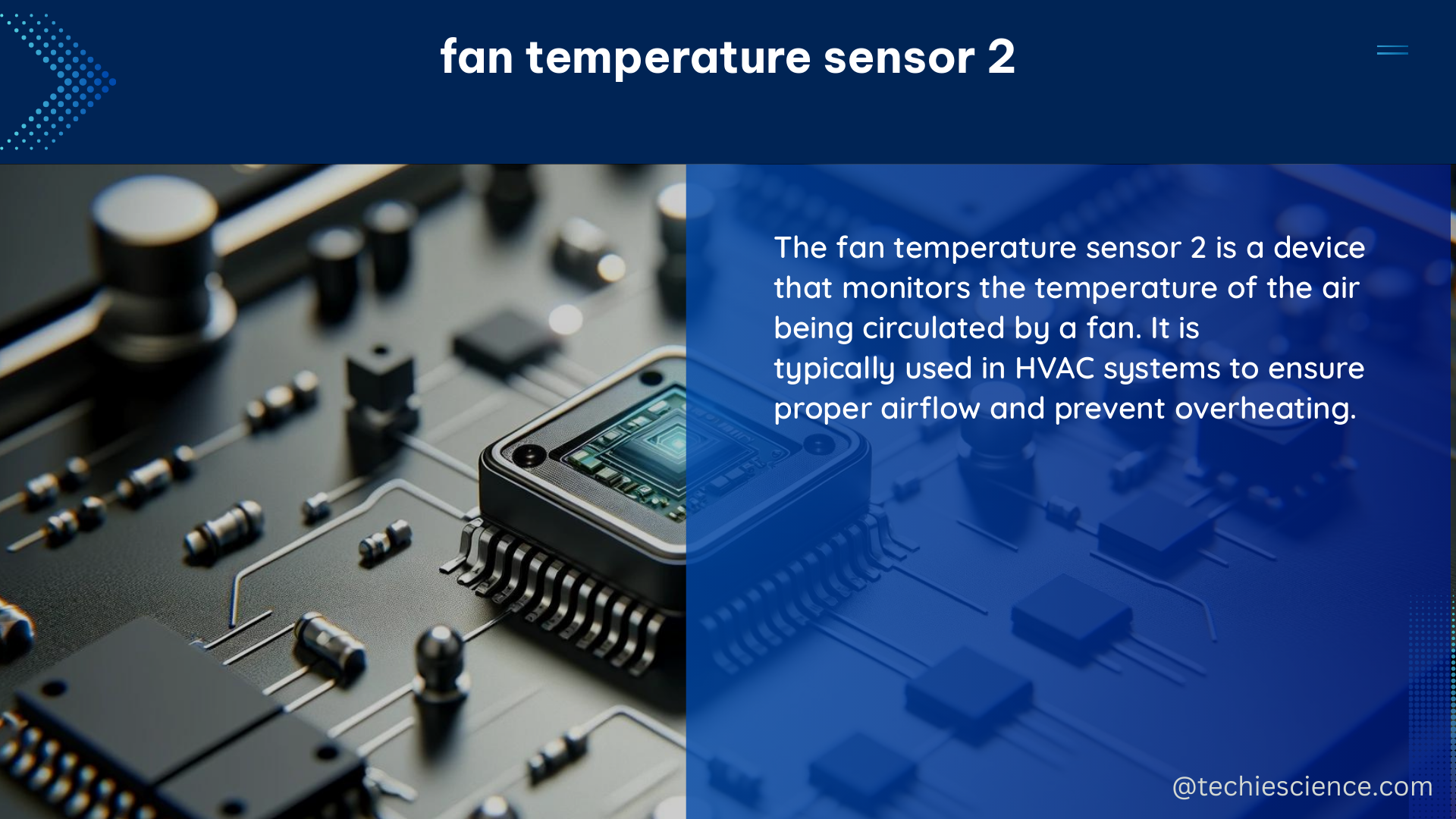The fan temperature sensor 2 is a crucial component in many systems, responsible for detecting, measuring, and reporting temperature variables. It is often used in conjunction with microcontrollers and other sensors to regulate temperature and ensure optimal system performance. The sensor’s accuracy and reliability are essential for maintaining system efficiency and preventing damage or failure.
Understanding the Importance of Fan Temperature Sensor 2
The fan temperature sensor 2 plays a vital role in various applications, including:
-
Automatic Hybrid Cooling Fan Systems: In the context of the automatic hybrid cooling fan project, the fan temperature sensor 2 is responsible for adjusting the fan speed based on the detected temperature. This ensures efficient cooling and prevents system overheating.
-
Plant Photosynthesis Measurement: The LI-6800 Portable Photosynthesis System utilizes temperature sensors to measure whole plant photosynthesis accurately. The sensor’s ability to provide precise temperature readings is crucial for the system’s functionality.
-
Building Automation and Retro-Commissioning: In the Retro-Commissioning Process Manual, the importance of properly calibrated sensors, including temperature sensors, is emphasized. Accurate temperature measurements are essential for efficient building management and energy optimization.
Technical Specifications of Fan Temperature Sensor 2

While specific technical specifications for the fan temperature sensor 2 may vary, we can look at the general characteristics of temperature sensors to understand their capabilities:
| Specification | Range | Accuracy | Resolution |
|---|---|---|---|
| Temperature | 0°C to 50°C | ±2°C | 0.1°C |
| Humidity | 20% to 90% RH | ±5% RH | 1% RH |
| Response Time | < 5 seconds | – | – |
| Supply Voltage | 3.3V to 5V | – | – |
These specifications are based on the DHT11 temperature and humidity sensor, which is a commonly used sensor in various applications. However, the fan temperature sensor 2 may have different technical characteristics depending on the manufacturer and model.
Designing a DIY Fan Temperature Sensor 2
Building a DIY fan temperature sensor 2 can be a rewarding project for those interested in electronics and system design. Here’s a step-by-step guide to help you get started:
-
Select a Temperature Sensor: Choose a temperature sensor that meets your project’s requirements. The DHT11 sensor is a popular and affordable option, but you may also consider other sensors like the DS18B20, BME280, or LM35, depending on your specific needs.
-
Connect the Sensor to a Microcontroller: Connect the temperature sensor to a microcontroller, such as an Arduino board or a Raspberry Pi. This will allow you to read temperature data from the sensor and use it to control other system components.
-
Write Code to Read Temperature Data: Develop code to read temperature data from the sensor. This typically involves using a library provided by the sensor manufacturer to interface with the sensor and retrieve the temperature measurements.
-
Test and Calibrate the Sensor: Thoroughly test the sensor to ensure it is providing accurate temperature readings. If necessary, calibrate the sensor using a calibrated field meter or other reference standard.
-
Integrate the Sensor into Your System: Once the sensor is working correctly, integrate it into your system to control fan speed or other components based on the temperature readings.
Here’s an example Arduino code snippet to get you started:
#include <DHT.h>
#define DHTPIN 2 // Digital pin connected to the DHT sensor
#define DHTTYPE DHT11 // DHT 11 sensor type
DHT dht(DHTPIN, DHTTYPE);
void setup() {
Serial.begin(9600);
dht.begin();
}
void loop() {
float temperature = dht.readTemperature(); // Read temperature in Celsius
if (isnan(temperature)) {
Serial.println("Failed to read temperature from DHT sensor!");
return;
}
Serial.print("Temperature: ");
Serial.print(temperature);
Serial.println("°C");
delay(2000); // Wait 2 seconds before the next reading
}
This code uses the DHT library to read temperature data from the DHT11 sensor and print the results to the serial monitor. You can modify this code to suit your specific project requirements, such as integrating the temperature data with a fan control system.
Conclusion
The fan temperature sensor 2 is a critical component in various systems, providing accurate and reliable temperature measurements. Understanding its technical specifications, design considerations, and integration into your project is essential for ensuring optimal system performance and preventing potential issues.
By following the steps outlined in this guide, you can build a DIY fan temperature sensor 2 and incorporate it into your own projects, whether it’s an automatic cooling system, a plant photosynthesis measurement setup, or a building automation and retro-commissioning application.
References
- Automatic Hybrid Cooling Fan End-of-Project Report. (2022). Retrieved from https://www.csus.edu/indiv/t/tatror/senior_design/SD%20F21-S22/Team_14_F21S22_EOP_Report.pdf
- Using the Small Plant Chamber – LI-COR. (n.d.). Retrieved from https://www.licor.com/env/support/LI-6800/topics/chamber-plant-note.html
- Retro-Commissioning Process Manual. (2014). Retrieved from https://www.cfm.va.gov/til/Cx-RCx/RetroCxManual.PDF
- DHT11-Technical-Data-Sheet-Translated-Version-1143054.pdf. (n.d.). Retrieved from https://www.mouser.com/datasheet/2/758/DHT11-Technical-Data-Sheet-Translated-Version-1143054.pdf

The lambdageeks.com Core SME Team is a group of experienced subject matter experts from diverse scientific and technical fields including Physics, Chemistry, Technology,Electronics & Electrical Engineering, Automotive, Mechanical Engineering. Our team collaborates to create high-quality, well-researched articles on a wide range of science and technology topics for the lambdageeks.com website.
All Our Senior SME are having more than 7 Years of experience in the respective fields . They are either Working Industry Professionals or assocaited With different Universities. Refer Our Authors Page to get to know About our Core SMEs.